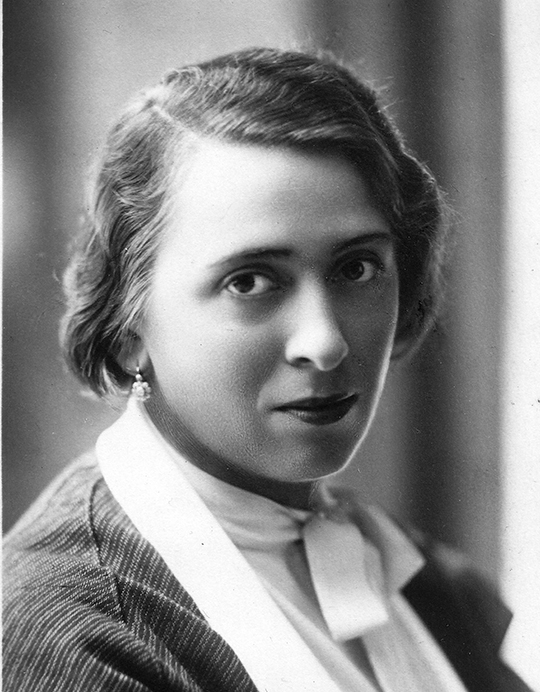
[Photo] J. Pogacnik
IT WAS CLOSING NIGHT OF THE YEARLONG RUN OF PAVLA OVER THE PRECIPICE, AND EVERY SEAT IN Ljubljana’s Slovenian Youth Theatre was occupied. Actors lowered themselves from the ceiling, or edged in from stage left, tiptoeing along holds attached to the wall. I sat spellbound, absorbing the energy from 270 audience members, concentrating on every movement, every word that celebrated the life of Pavla Jesih. The strength of her character seemed to fill the room.
BORN IN LJUBLJANA IN 1901, Pavla learned to climb with Slovenia’s Club Skala. She often took the sharp end, and in 1925 she and Dana Kuraltova completed the first Slovenian all-female ascent of the Slovenian Route on the north face of Triglav, her country’s highest mountain. Female climbers weren’t common then, and their presence caused occasional discomfort. That same year, Pavla wrote in her journal about a climb with British expatriate Fanny Copeland. One of their male partners, Alojz de Reggi, “answered all of Miss’s questions with curt ‘Yes, yes, of course, get a move on, that’s it, you see you’re doing just fine,’ all the while keeping his eyes carefully averted.”
But Pavla didn’t depend on men to climb; she relied on her own innate sense of route finding to trace bold lines on the deviously complex limestone walls of the Julian Alps. She named many of her first ascents “Skala“– “rock”–because of her loyalty to the club. Over time, she and another prominent woman, Mira Debelak, became known as “the Slovenian interwar alpinist matriarchy.”
In 1933 Pavla fell thirty meters on the craggy peak of Mojstrovka. During her long recovery, she opened a successful chain of cinemas. In 1941 the Second World War spread to Slovenia, then part of Yugoslavia, putting a halt to climbing. The invaders burned numerous mountain huts; those that survived became the property of the German Alpine Club. As barbed wire surrounded Ljubljana, the Alpine Association of Slovenia headquarters was cut off from the countryside. Nevertheless, the organization became a gathering place for the Slovenian resistance, and Pavla supported the Partisan fighters with food, supplies and intelligence.

[Photo] Banff Centre
After the occupation ended in 1945, Pavla went back to Triglav’s north wall. For years, she’d studied a long, exposed unclimbed pillar, but the war had given her no opportunity to train. She was now forty-four.
Her climbing partner, Joza Cop, was fifty-two. Using oral accounts, Evgen Lovsin reconstructed their ascent in the alpine journal Planinki zbornik. Facing a difficult overhanging move on the third day, Cop “writhed like a fish under a boulder, grabbing blindly for higher handgrips.” As Pavla followed him, she slid off and was left hanging in midair. She tried repeatedly to swing herself back onto the rock. In the end, Cop lowered her to a tiny ledge: “She pulled her coat over her head, wedged her legs against a rock and closed her eyes.”
Cop finished alone and descended for help. Because of dense fog, the rescue party didn’t reach Pavla until her fifth day on the wall. Revived, she insisted on completing the route unassisted. For political reasons, however, the climb became simply “Cop’s Pillar.” The wealthy Pavla was out of favor in postwar Yugoslavia, now under Communist rule. Despite her involvement in the resistance movement, the dictator Tito and his cronies accused her of being a traitor. Ultimately, Pavla lost almost everything: her freedom to travel and climb, her cinemas and her living. But she never betrayed her so-called co-conspirators or admitted guilt in the relentless sham trials. For a time, she worked as a housekeeper in mountain huts. Gradually, her former life vanished from the public eye. In the end, she had barely enough money to buy seed for the park pigeons or cigarettes for herself. She died in obscurity in 1976. The Slovenian theater director Matjaz Pograjc discovered her story while sifting through historical papers. A climber himself, he was dismayed that this brave woman had been silenced in such a systematic way. So he created his play to restore her memory. And as the actors danced along the walls and flew through the air, suspended on harnesses, they brought to life a lost vision of a remarkable woman–radiant as ever, surrounded by steep stone, alpine light and beloved friends.